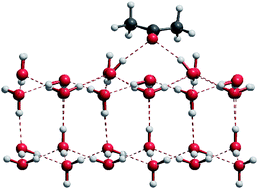Simulation of absorption sites of acetone at ice: (0001) surface, bulk ice and small-angle grain boundaries†
Abstract
Local structures and energies were calculated for the interaction of

* Corresponding authors
a
Institute of Inorganic and Analytical Chemistry, University of Frankfurt, Max-von-Laue-Strasse 7, Frankfurt am Main, Germany
E-mail:
m.schmidt@chemie.uni-frankfurt.de
Fax: +49 69 79829235
Tel: +49 69 79829171
b Institute of Pure and Applied Chemistry, Carl von Ossietzky University Oldenburg, Carl von Ossietzky-Strasse 9-11, Oldenburg, Germany
c Institute of Physical and Theoretical Chemistry, University of Frankfurt, Max-von-Laue-Str. 7, Frankfurt am Main, Germany
Local structures and energies were calculated for the interaction of

 Please wait while we load your content...
Something went wrong. Try again?
Please wait while we load your content...
Something went wrong. Try again?
S. M. Hammer, R. Panisch, M. Kobus, J. Glinnemann and M. U. Schmidt, CrystEngComm, 2009, 11, 1291 DOI: 10.1039/B820918A
To request permission to reproduce material from this article, please go to the Copyright Clearance Center request page.
If you are an author contributing to an RSC publication, you do not need to request permission provided correct acknowledgement is given.
If you are the author of this article, you do not need to request permission to reproduce figures and diagrams provided correct acknowledgement is given. If you want to reproduce the whole article in a third-party publication (excluding your thesis/dissertation for which permission is not required) please go to the Copyright Clearance Center request page.
Read more about how to correctly acknowledge RSC content.
 Fetching data from CrossRef.
Fetching data from CrossRef.
This may take some time to load.
Loading related content
